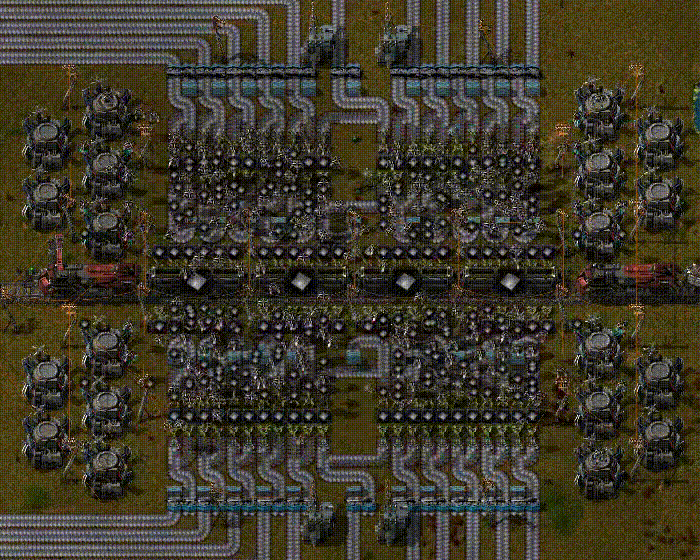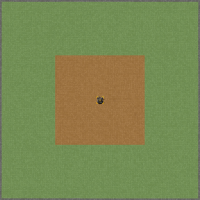User:Pelia/Bleh/cs

Logistická síť je řada různých logistických truhel a logistických robotů řízená jedním či více roboporty.
V závislosti na rozložení roboportů a truhel (a použitých typů) mohou roboti mezi nimi přenášet materiál jakožto energeticky náročnější alternativa oproti pásům nebo železnici. Výměnou roboti disponují vysokou pohyblivostí díky schopnosti létat přímou čarou.
Hráč se také může chovat jako požadavková truhla v logistické síti,allowing them to 'request' various items be kept at a set limit within their personal inventory. After researching Character logistic slots, they can configure an amount of items; and Logistic robots will start to move the specified items from the network to the character's inventory.
Do not mix up logistics network and circuit network. They share common components, but are otherwise disconnected and do not exchange any information. Also, do not mix up logistic network with construction network or combinations of the two called Robotic network.
Achievements

|
Dostal jsi zásilku Supply the character by logistic robot. |

|
Zásilková služba Supply the character with 10k items delivered by logistic robots. |

|
Logistická síť? Na co... Finish research with space science pack for the base game or any planetary science pack for Space Age |
Items
| Entity | Description |
|---|---|
| Roboport | Center of the Robotic network in which the Robots operate. Roboport coverage defines the area of the logistic network. Robots need to periodically return here to recharge. |
| Logistický robot | Moves items between Logistic Chests.1 |
| Aktivní poskytovací truhla | Logistic Chest: Pushes stored items into the logistic network.2 |
| Pasivní poskytovací truhla | Logistic Chest: Places stored items at the logistic network's disposal.2 |
| Skladovací truhla | Logistic Chest: Stores items currently not requested. Supplies stored items to the Logistic network.2 |
| Přijímací truhla | Logistic Chest: Will be filled by Logistic robots until the configured amount is reached, or the chest becomes full. Can request multiple different types of items.2 |
(1) Default capacity is 1 item per robot. This can be increased by researching Worker robot cargo size (research).
(2) Logistic chests can also be connected to the Circuit network with red wire or green wire.
Use
To start with, just use passive provider- and requester chests. Place the passive provider chests at the output inserters of assembling machines and requester chests at the input (let them request the needed items). Place a Roboport, which covers these chests with the inner orange area. Place some logistic bots. The robots will fly out of the top hatch and will begin to work. You can now limit the number of produced item either with the stack limitation-feature.
Logistic network is very capable for creating more and more complex items in a relatively small factory-area. Low complexity and high volume activities over longer distances (like smelting) can (and should) be left using belts or railway network.

The basic thing needed for item transportation are Roboports. When placing the port and hover over it, notice an orange and a larger green area.
- The orange zone is the Logistic Network area. This is also the maximum distance for connecting two roboports.
- The green zone is the Construction area.
For more info on the specifics of how roboports work, check the page dedicated to them.
Expand the logistic zone
There can be many separate logistic networks. Two roboports are in the same network only if they are connected, as described above. Visually this is represented by a dashed yellow line connecting them. To prevent roboports from linking, the Player needs to build them far enough away from each other so that the orange zones don't touch.
Bots do not fly from one network into another, unless requiring a recharge. Robots will never "nest" in a different network.
Losing bots
Logistics robots are a priority target of biters, and will prioritize attacking them over many objects in the vicinity of the robots. Destroyed robots will not be replaced, unless automatic control of the robot creation system is used.
Bots are not destroyed when running out of energy, but will be reduced to 20% of their speed, which gives them the chance to recharge eventually and a chance for the player to notice the problem.
Pay attention to robotic networks which form some kind of U-shape (where the shortest way between two chests goes over an uncovered area): if a bot runs out of charge in this area, and cannot return fast enough to a roboport, the bot will be significantly slowed and as a result the logistics network will frequently slow down, with large groups of bots slowly flying over the uncovered area.
Robots may run out of charge on longer journeys. When the charging-queue for the bots gets too long, the bots (and their loads) will slow down. Generally, a roboport can charge between 50 and 70 bots per min, 4 at a time, but are not very efficient at charging large queues of bots and can quickly become overworked. Place more roboports near the first one to share the load.
Negative numbers
It is possible to notice negative numbers on the 'Logistic Network'-Screen when looking at network storage. Contrary to common belief, this is intended.
The logistic network numbers report items in provider and storage chests, minus the amount of items scheduled to be picked up by robots. When negative numbers are shown, it means that more items are being requested than are available in the network. There is a deficit. This can be a problem, or intended, depending on the player's choice. The negative value is just to explain why items aren't being delivered. For example, a deficit of 20 iron plates would look like this:
Receiving more items than requested
The delivered number of items in the requester chest can be higher than requested. This depends on the researched Worker robot cargo size-bonus, since bots will always take as much as they can carry if an unlimited amount is available.
Priorities of robots
This overview reflects the priorities in which order the chests are filled/emptied.
The logistic network looks for orders by the chests in this order:
- A requested item is first looked up in the active provider chests, then in the storage chests, then the passive provider chests. So, the active provider chests are emptied first, then the storage chests, then the passive provider chests.
- If robots are free and there is space left in storage chests, and there are unrequested items in an active provider chests, the items are moved from active provider to a storage chest.
- For the storage chests, the bots search for one storage which has the same item already. If that can't be found, they choose the first storage chest with a free slot from the list, which is sorted by the order they were built in. [1] This is to avoid having storage chests with different items inside, allowing greater organisation.
Storage chests will be filled with items from active provider chests, and from construction robots that have had their orders cancelled while they were carrying items.
Order of movement
The bots fulfill all requests with the same priority. The algorithm looks for the next free robot, then the next request in the queue and after giving orders to the robot, this request is put at the end of the queue, so that first all other requests are done.
Distance
When looking to pick up requested items from multiple chests of equal priority, bots will always choose the closest one. [2] This is however only true when an item is being requested, not when an item is sent away. [3] In the case of items being sent into the logistics network distance does not matter, and the rules laid out above matter instead.